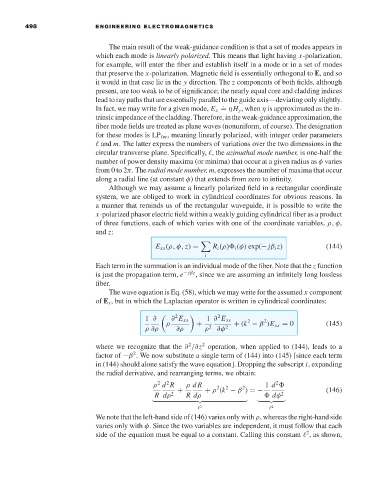Page 516 - Engineering Electromagnetics, 8th Edition
P. 516
498 ENGINEERING ELECTROMAGNETICS
The main result of the weak-guidance condition is that a set of modes appears in
which each mode is linearly polarized. This means that light having x-polarization,
for example, will enter the fiber and establish itself in a mode or in a set of modes
that preserve the x-polarization. Magnetic field is essentially orthogonal to E, and so
it would in that case lie in the y direction. The z components of both fields, although
present, are too weak to be of significance; the nearly equal core and cladding indices
lead to ray paths that are essentially parallel to the guide axis—deviating only slightly.
.
In fact, we may write for a given mode, E x = ηH y , when η is approximated as the in-
trinsicimpedanceofthecladding.Therefore,intheweak-guidanceapproximation,the
fiber mode fields are treated as plane waves (nonuniform, of course). The designation
for these modes is LP m , meaning linearly polarized, with integer order parameters
and m. The latter express the numbers of variations over the two dimensions in the
circular transverse plane. Specifically, , the azimuthal mode number, is one-half the
number of power density maxima (or minima) that occur at a given radius as φ varies
from 0 to 2π. The radial mode number, m,expresses the number of maxima that occur
along a radial line (at constant φ) that extends from zero to infinity.
Although we may assume a linearly polarized field in a rectangular coordinate
system, we are obliged to work in cylindrical coordinates for obvious reasons. In
a manner that reminds us of the rectangular waveguide, it is possible to write the
x-polarized phasor electric field within a weakly guiding cylindrical fiber as a product
of three functions, each of which varies with one of the coordinate variables, ρ, φ,
and z:
E xs (ρ, φ, z) = R i (ρ) i (φ)exp(− jβ i z) (144)
i
Each term in the summation is an individual mode of the fiber. Note that the z function
is just the propagation term, e − jβz , since we are assuming an infinitely long lossless
fiber.
The wave equation is Eq. (58), which we may write for the assumed x component
of E s ,but in which the Laplacian operator is written in cylindrical coordinates:
2
2
1 ∂ ∂ E xs 1 ∂ E xs 2 2
ρ + + (k − β )E xs = 0 (145)
ρ ∂ρ ∂ρ ρ 2 ∂φ 2
2
2
where we recognize that the ∂ /∂z operation, when applied to (144), leads to a
factor of −β .Wenow substitute a single term of (144) into (145) [since each term
2
in (144) should alone satisfy the wave equation]. Dropping the subscript i,expanding
the radial derivative, and rearranging terms, we obtain:
2
2
2
ρ d R ρ dR 2 2 2 1 d (146)
R dρ 2 + R dρ + ρ (k − β ) =− dφ 2
2 2
We note that the left-hand side of (146) varies only with ρ, whereas the right-hand side
varies only with φ. Since the two variables are independent, it must follow that each
2
side of the equation must be equal to a constant. Calling this constant ,as shown,

